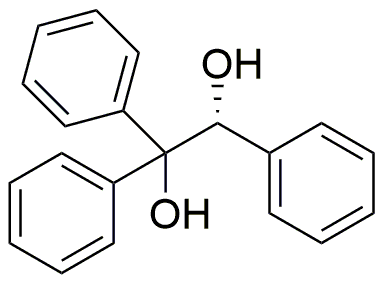(R)-(+)-1,1,2-Triphenyl-1,2-ethanediol is widely utilized in research focused on
- Chiral Synthesis: This compound serves as a chiral building block in the synthesis of pharmaceuticals, enhancing the production of optically active compounds that are crucial in drug development.
- Research in Catalysis: It is used in asymmetric catalysis, where it helps in creating specific enantiomers, offering a more efficient pathway for producing desired chemical products.
- Material Science: The compound is explored in the development of advanced materials, including polymers and coatings, due to its unique structural properties that improve material performance.
- Biochemical Studies: Its role as a ligand in biochemical research allows for the study of enzyme mechanisms and interactions, providing insights into biological processes.
- Pharmaceutical Formulations: It is incorporated into drug formulations to enhance solubility and stability, ensuring better delivery and efficacy of therapeutic agents.
Informations générales
Propriétés
Sécurité et réglementation
Applications
(R)-(+)-1,1,2-Triphenyl-1,2-ethanediol is widely utilized in research focused on
- Chiral Synthesis: This compound serves as a chiral building block in the synthesis of pharmaceuticals, enhancing the production of optically active compounds that are crucial in drug development.
- Research in Catalysis: It is used in asymmetric catalysis, where it helps in creating specific enantiomers, offering a more efficient pathway for producing desired chemical products.
- Material Science: The compound is explored in the development of advanced materials, including polymers and coatings, due to its unique structural properties that improve material performance.
- Biochemical Studies: Its role as a ligand in biochemical research allows for the study of enzyme mechanisms and interactions, providing insights into biological processes.
- Pharmaceutical Formulations: It is incorporated into drug formulations to enhance solubility and stability, ensuring better delivery and efficacy of therapeutic agents.
Documents
Fiches de données de sécurité (FDS)
La FDS fournit des informations de sécurité complètes sur la manipulation, le stockage et l’élimination du produit.
Spécifications du produit (PS)
Le PS fournit une description complète des propriétés du produit, notamment sa composition chimique, son état physique, sa pureté et les exigences de stockage. Il détaille également les plages de qualité acceptables et les applications prévues du produit.
Certificats d'analyse (COA)
Recherchez des certificats d'analyse (COA) en saisissant le numéro de lot du produit. Les numéros de lot et de lot se trouvent sur l'étiquette d'un produit, après les mots « Lot » ou « Lot de fabrication ».
Numéro de catalogue
Numéro de lot/série
Certificats d'origine (COO)
Ce certificat d'exploitation confirme le pays dans lequel le produit a été fabriqué, et détaille également les matériaux et composants utilisés et s'il est issu de sources naturelles, synthétiques ou autres sources spécifiques. Ce certificat peut être requis pour les douanes, le commerce et la conformité réglementaire.
Numéro de catalogue
Numéro de lot/série
Fiches de données de sécurité (FDS)
La FDS fournit des informations de sécurité complètes sur la manipulation, le stockage et l’élimination du produit.
DownloadSpécifications du produit (PS)
Le PS fournit une description complète des propriétés du produit, notamment sa composition chimique, son état physique, sa pureté et les exigences de stockage. Il détaille également les plages de qualité acceptables et les applications prévues du produit.
DownloadCertificats d'analyse (COA)
Recherchez des certificats d'analyse (COA) en saisissant le numéro de lot du produit. Les numéros de lot et de lot se trouvent sur l'étiquette d'un produit, après les mots « Lot » ou « Lot de fabrication ».
Numéro de catalogue
Numéro de lot/série
Certificats d'origine (COO)
Ce certificat d'exploitation confirme le pays dans lequel le produit a été fabriqué, et détaille également les matériaux et composants utilisés et s'il est issu de sources naturelles, synthétiques ou autres sources spécifiques. Ce certificat peut être requis pour les douanes, le commerce et la conformité réglementaire.


